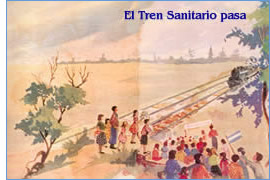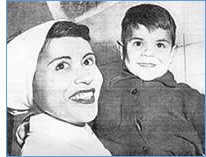 Universal and affordable health care had long been a goal of Peron and
Evita. Universal and affordable health care had long been a goal of Peron and
Evita.
During the early years of his presidency, Peron had voiced his concern
for those who could not afford adequate medical care: “The state
must offer integral medical assistance to those who earn least. If I am
taken ill and I am a millionaire, I will bring specialists from all over
the world, ...and I would have a good possibility of saving my life. The
poor, on the other hand, have no chance at all of doing that. ... [In]
the interior of the country, ... 50% of those who die do so without any
medical attention.
“In the country of meat, in the country of bread, in the country
which has 300 days of sunlight a year, in the country where we have everything
... the lifespan is ...ten years less than in the U.S. Organizing public
health care can prolong our lives by an average of ten to twenty years.”
La Nacion Argentina: Justa, Libre, Soberana
Ed. Peuser, Buenos Aires, 1950, pg. 321
 In
1951, with the idea that if not all descamisados could go to the policlinicos,
then a policlinico should go to them, the Fundacion inaugurated a new
style of medical care: el Tren Sanitario, the “Health Care Train.”
Sent by the Policlínico Presidente Perón, the train consisted
of twelve cars and carried forty-six health care specialists throughout
the country; in four months it chugged its way throughout Argentina. One
car was set up as a theater which showed movies to educate the public
about basic hygiene and preventive medicine. Equipped with living and
dining quarters for its personnel, its own generator, pharmacy, laboratories,
x-ray rooms, and a waiting room, an operating theater and a delivery room,
the Health Care Train offered medical and dental check-ups, x-rays, vaccinations,
medicine, OBGYN services: all free. In
1951, with the idea that if not all descamisados could go to the policlinicos,
then a policlinico should go to them, the Fundacion inaugurated a new
style of medical care: el Tren Sanitario, the “Health Care Train.”
Sent by the Policlínico Presidente Perón, the train consisted
of twelve cars and carried forty-six health care specialists throughout
the country; in four months it chugged its way throughout Argentina. One
car was set up as a theater which showed movies to educate the public
about basic hygiene and preventive medicine. Equipped with living and
dining quarters for its personnel, its own generator, pharmacy, laboratories,
x-ray rooms, and a waiting room, an operating theater and a delivery room,
the Health Care Train offered medical and dental check-ups, x-rays, vaccinations,
medicine, OBGYN services: all free.
One of Evita’s greatest accomplishments was surely that of universal
health care. She herself was operated on at the Policlínico Presidente
Perón; at the time of her death, for the first time in Argentine
history, “there was no inequality in Argentine health care.”
[Navarro, pg. 131] How many nations have achieved that goal in just seven
years... or even tried to?
Bibliography
Ferioli,
Néstor. La Fundación Eva Perón / 2. Buenos
Aires:Centro Editor de América Latina, 1990.
Fraser, Nicholas
& Marysa Navarro. Evita: The Real Life of Eva Perón.
New York: W.W. Norton & Company, 1996.
Ortiz, Alicia
Dujovne. Eva Perón. New York: St. Martin’s Press,
1996.
Fundación
Eva Perón. Eva Perón and Her Social Work. Buenos
Aires: Subsecretaria de Informaciones, 1950.
La Nación
Argentina: Justa, Libre, Soberana. Buenos Aires: Ediciones Peuser,
1950.
Mundo
Peronista . 1951. |





